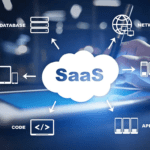The way companies acquire and use software has changed so much that you barely recognize it. Gone are the days of installing programs on an office full of desktops and servers. Now, everything is moving to the cloud. But should businesses stick with old-school software or make the switch to the latest cloud-based solutions?
Indeed, the rapid pace of technology can leave heads spinning! To help clear things up, this article will dive into the key differences between traditional on-premises software and newfangled software-as-a-service (SaaS). We’ll explore the benefits and drawbacks of each.
The Rise of Software-as-a-Service
So what is SaaS? It refers to applications hosted in the cloud and accessed by users online via subscription. With SaaS, the software vendor takes care of all the technical responsibilities, including hosting, maintenance, security, and upgrades. Meanwhile, users simply log in and use the software as needed without installing anything locally.
SaaS has completely transformed how organizations acquire and use software. SaaS businesses like Salesforce, Office 365, Box, and ServiceNow are in high demand among clients due to their software delivery model. Statista predicts that the SaaS market will be worth approximately $197 billion in 2023 and $232 billion in 2024. This growth reflects the tremendous appeal of offloading the hassle of software management to vendors while gaining flexibility.
Benefits of Embracing SaaS
There are compelling reasons why SaaS has overtaken traditional software:
- Access from anywhere. Employees can work productively whether they are in the office, at home, traveling, or anywhere with an internet connection. For example, sales reps can easily access CRM data in the field via mobile devices.
- Quick deployment. Without lengthy installations, SaaS solutions can be implemented in weeks rather than months. When COVID hit, the SaaS company Zoom was able to rapidly onboard huge numbers of customers thanks to its SaaS delivery model.
- Lower startup costs. Organizations avoid massive upfront licensing fees by paying monthly or annual SaaS subscriptions. This way, businesses can acquire software and control expenditures.
- Automatic updates. Users always have the most current version of the software since vendors push updates seamlessly in a SaaS model.
- Scalability on demand. SaaS makes it easy to scale user licenses and features up or down as needed. CRM provider Salesforce enables businesses to instantly adjust capacity to match workloads and growth.
- Enhanced collaboration. The cloud-based nature of SaaS supports real-time collaboration across the organization. For example, dispersed team members can work together on documents in solutions like Office 365 or Google Workspace.
The Case for Traditional On-Premises Software
Many organizations still rely on traditional on-premises software installed on local servers. Examples include programs like Office suites, databases, ERP systems, CRMs, and custom line-of-business apps. With on-premises software, the organization manages the full technology stack in-house, including servers, operating systems, security layers, storage, and personnel.
Although complex and costly to manage, on-premises software offers advantages:
- Greater customization. On-premises systems allow for more robust customization to meet specialized business needs that off-the-shelf SaaS may not accommodate.
- Heightened security. Keeping systems in-house provides tighter control and security over sensitive data, which is critical for organizations like healthcare providers and financial institutions.
- Compliance. Heavily regulated industries often prefer or mandate on-premises software to meet strict data residency and privacy regulations.
- Legacy integration. Transitioning legacy systems to the cloud can be challenging or impossible. Maintaining them on-premises avoids this issue.
The Drawbacks to Consider
While SaaS and on-premises software both have clear benefits, there are also potential downsides to consider with each approach.
Drawbacks of SaaS:
- Integration challenges. Many SaaS platforms have fewer pre-built integrations compared to mature on-premises enterprise software systems that have been around for years. Creating custom integrations between SaaS apps and existing legacy systems via APIs can be time-consuming and complex.
- Dependence on the vendor. With SaaS, organizations are dependent on the vendor’s support and operations. Any internet downtime, cyberattacks on the vendor, hardware failures, or data breaches can result in application outages. Being reliant on an outside provider means less control over continuity and risk mitigation.
- Limited control. With data residing in the vendor’s cloud infrastructure, companies lose a degree of control and transparency. They must trust the vendor is securing data properly, allowing regulatory access when required, and providing adequate visibility into security practices.
Drawbacks of on-premises software:
- Ongoing management overhead. Substantial IT personnel resources are needed to handle daily software operations, apply upgrades and patches, manage security layers, maintain infrastructure, and provide user support. This ongoing cost and complexity burden can stretch limited IT teams.
- Slower updates. On-premises systems require rigorous testing of any new software patches or version updates before being rolled out incrementally across the organization.
- Scalability challenges. Scaling usage up or down in response to business needs or seasons requires purchasing and configuring additional hardware capacity.
- Lack of accessibility. Access to on-premises software is constrained to the office network unless remote access VPN capabilities are configured. This hampers the ability for remote or traveling employees to utilize the software.
Conclusion
Carefully weighing both the advantages and risks of SaaS and on-premises models is crucial for making the optimal software decision. Analyzing the potential drawbacks will lead to a more informed strategic choice
Research Snipers is currently covering all technology news including Google, Apple, Android, Xiaomi, Huawei, Samsung News, and More. Research Snipers has decade of experience in breaking technology news, covering latest trends in tech news, and recent developments.
